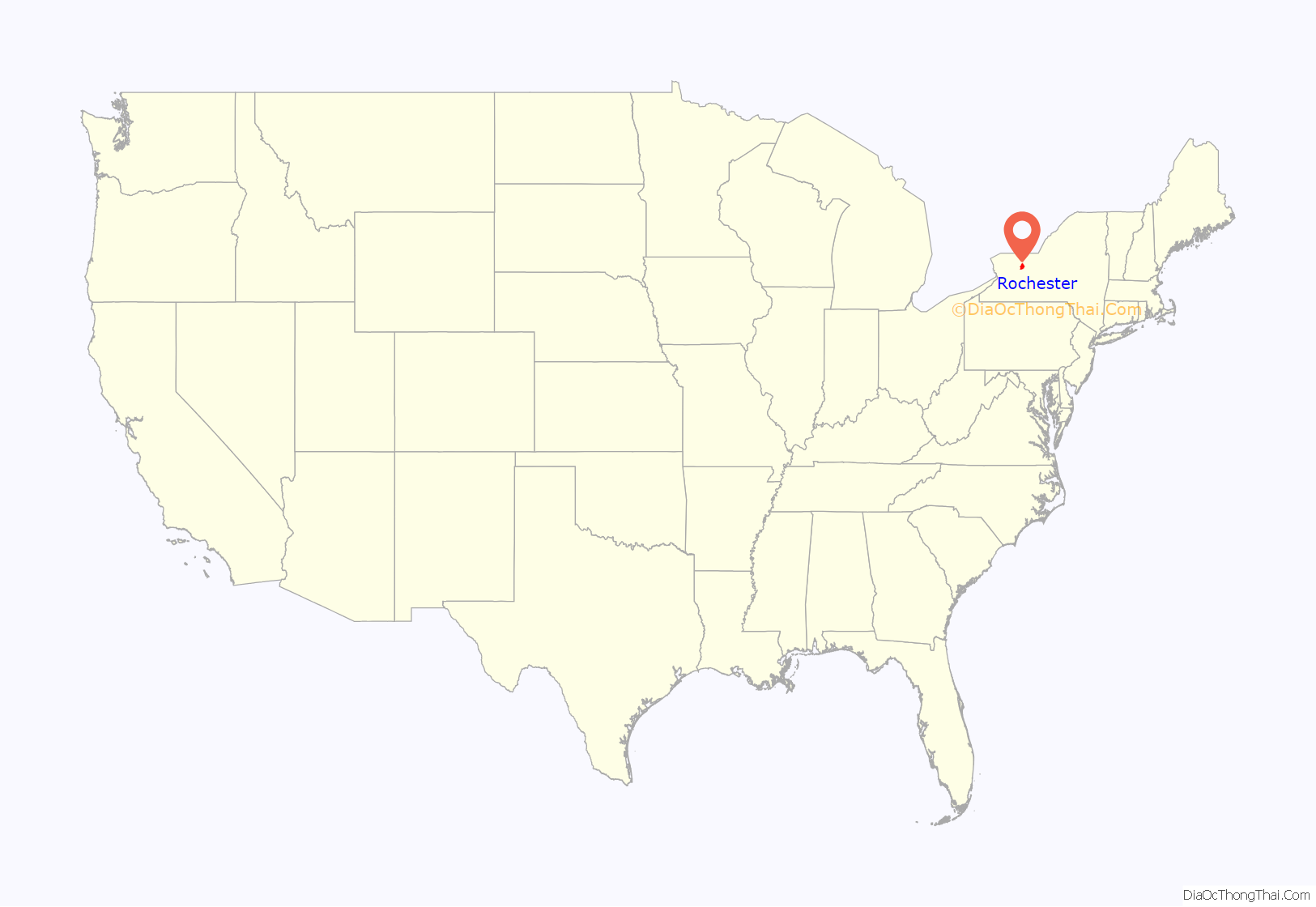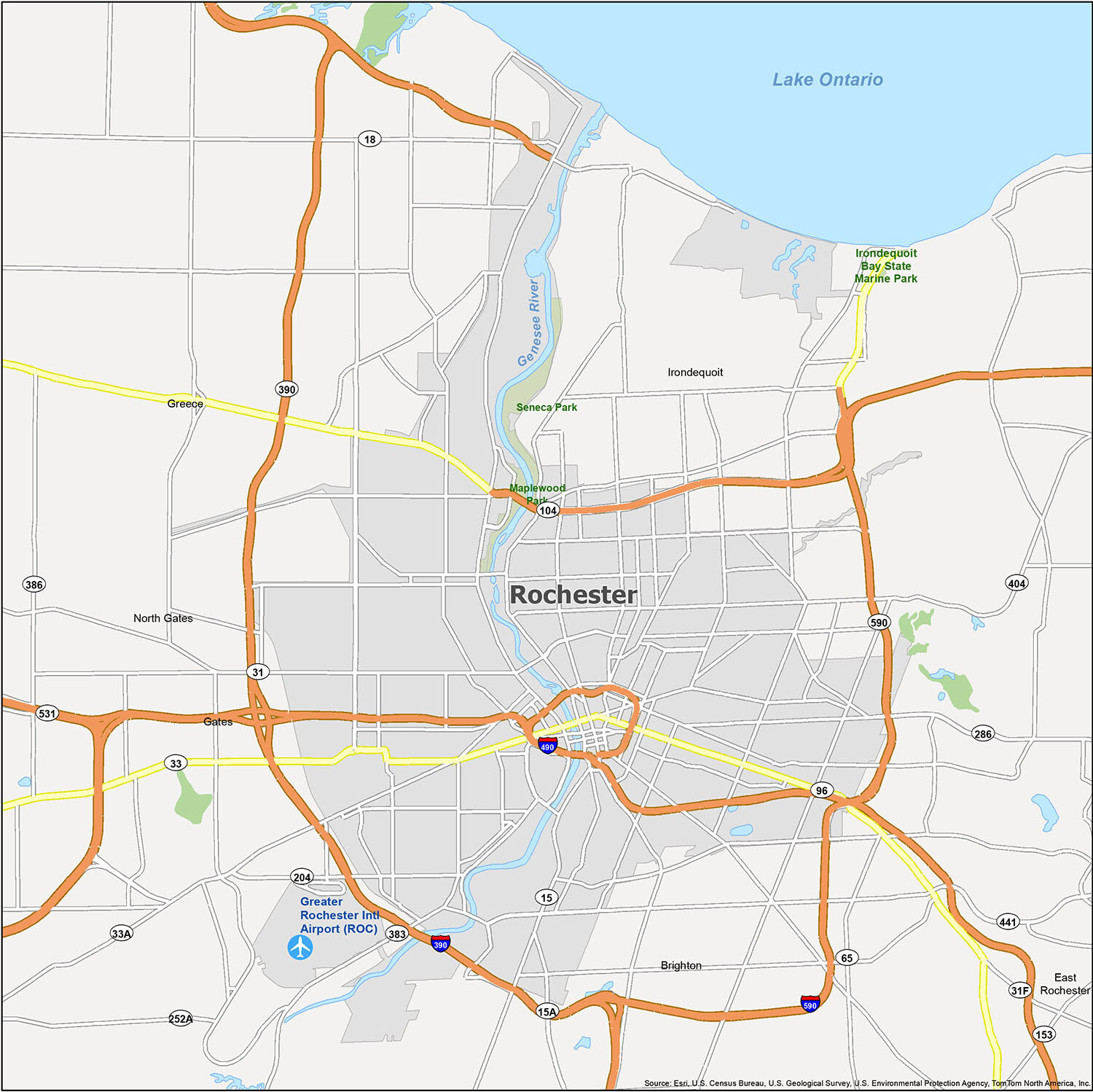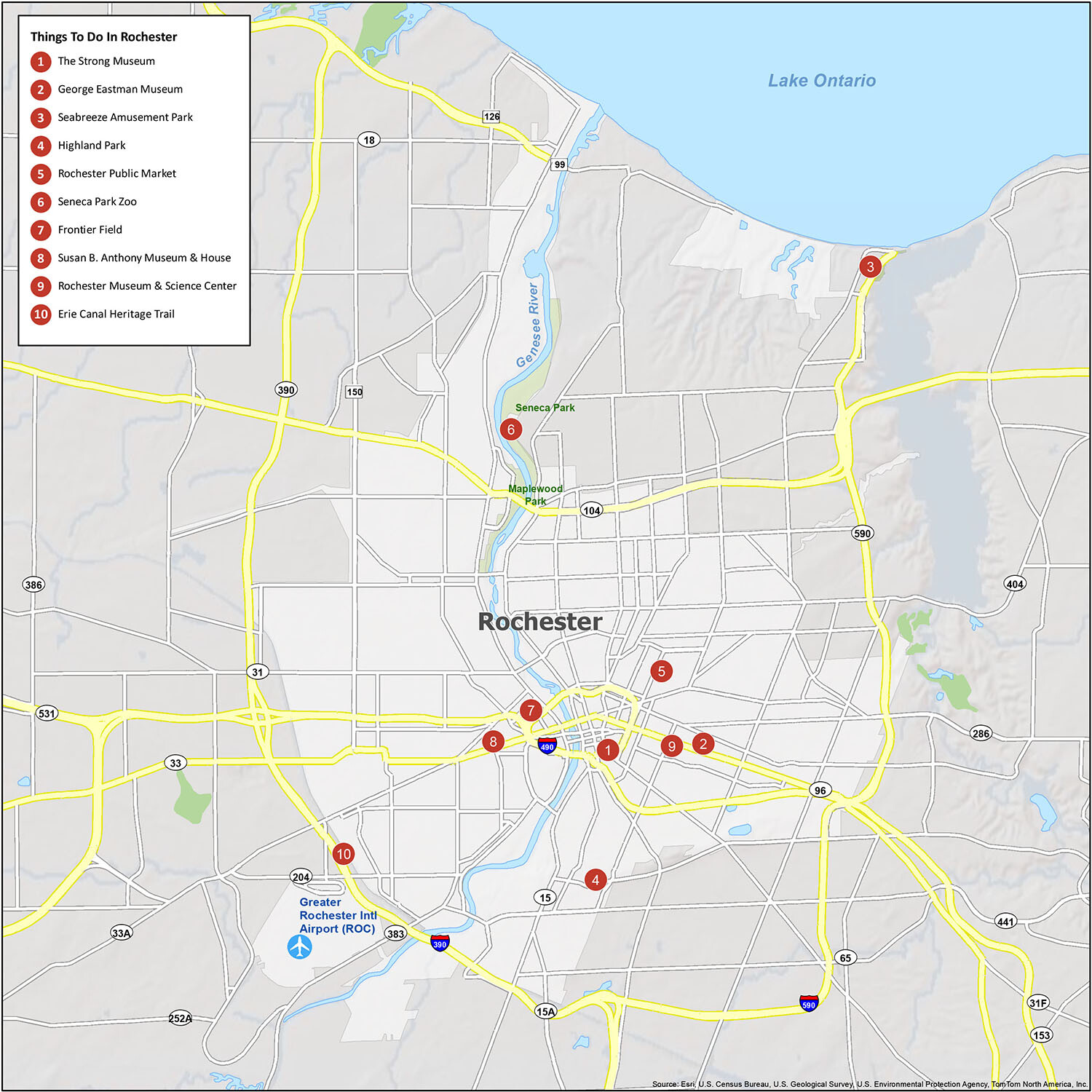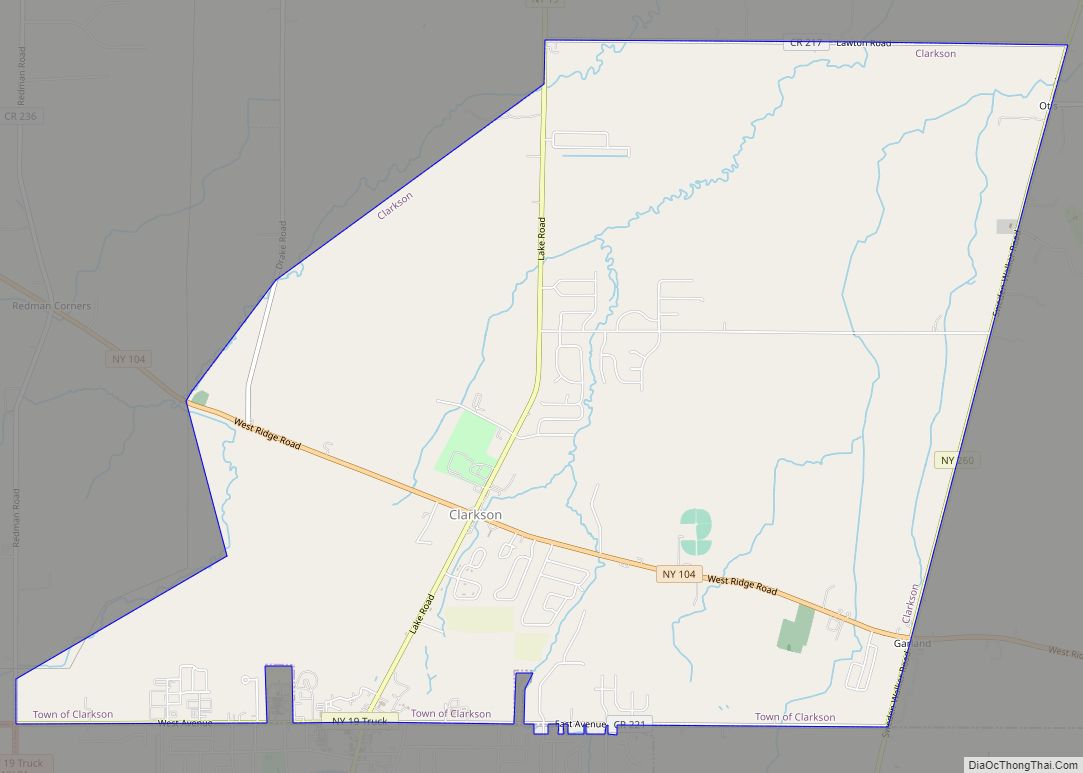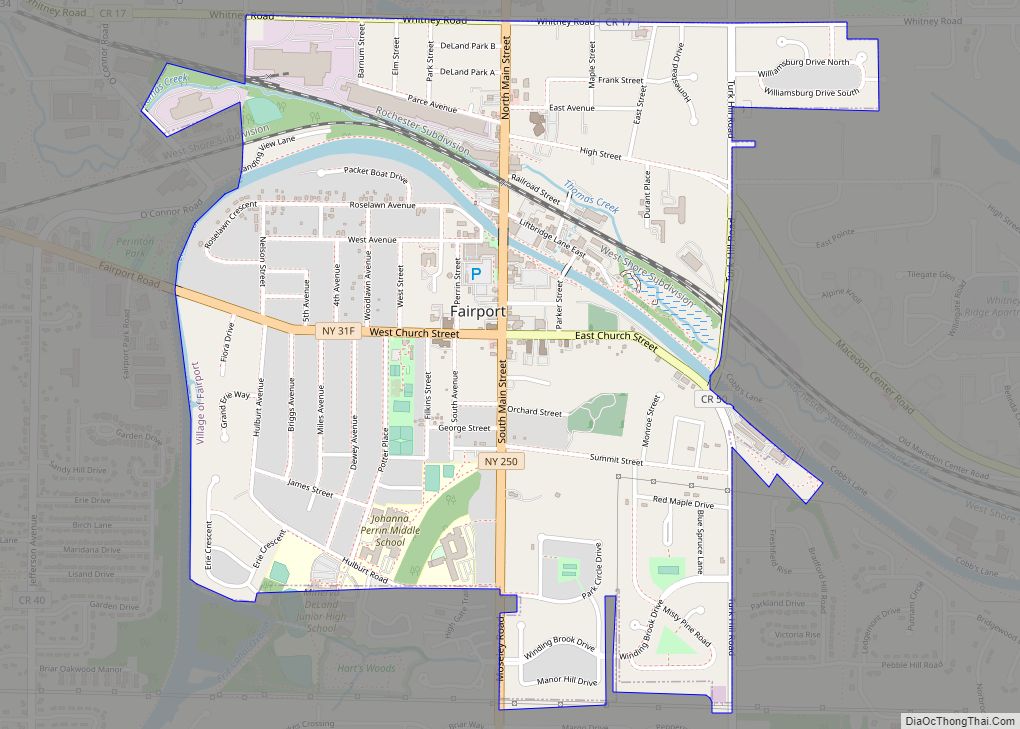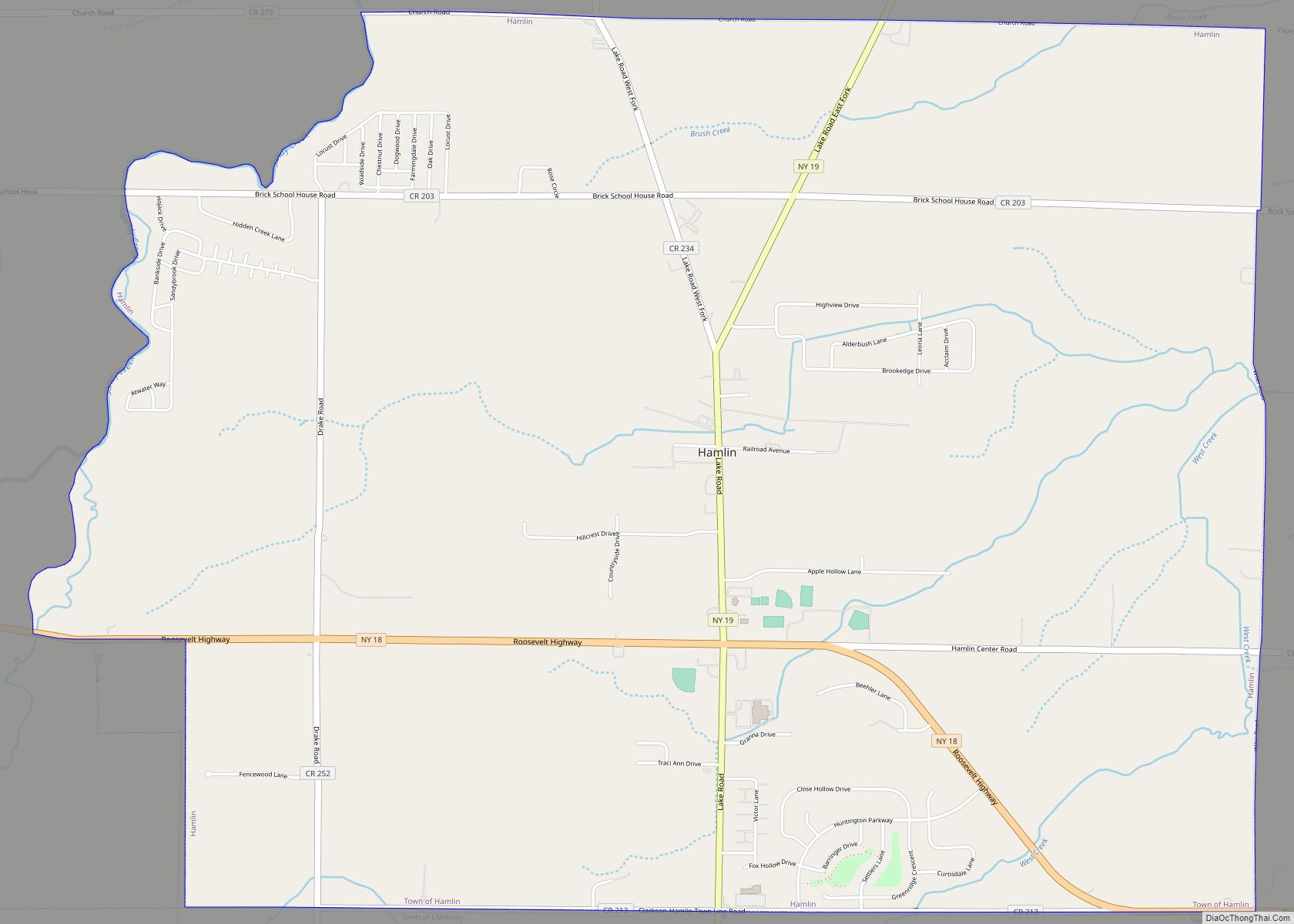Rochester (/ˈrɒtʃɛstər, -ɪs-/) is a city in the U.S. state of New York, the seat of Monroe County, and the fourth-most populous in the state after New York City, Buffalo, and Yonkers, with a population of 211,328 at the 2020 United States census. Located in Western New York, the city of Rochester forms the core of a larger metropolitan area with a population of 1 million people, across six counties. The city was one of the United States’ first boomtowns, initially due to the fertile Genesee River Valley, which gave rise to numerous flour mills, and then as a manufacturing center, which spurred further rapid population growth.
Rochester rose to prominence as the birthplace and home of some of America’s most iconic companies, in particular Eastman Kodak, Xerox, and Bausch & Lomb (along with Wegmans, Gannett, Paychex, Western Union, French’s, Constellation Brands, Ragú, and others), by which the region became a global center for science, technology, and research and development. This status has been aided by the presence of several internationally renowned universities (notably the University of Rochester and Rochester Institute of Technology) and their research programs; these schools, along with many other smaller colleges, have played an increasingly large role in Greater Rochester’s economy. Rochester has also played a key part in US history as a hub for certain important social and political movements, especially abolitionism and the women’s rights movement.
Today, Rochester’s economy is defined by technology and education (aided by a highly educated workforce, research institutions, and other strengths born in its past). The city experienced significant population decline due to deindustrialization in the late 20th century. However, its bedrock companies such as Eastman Kodak and Xerox shrank much less severely than the heavy industry steel companies in Buffalo and Pittsburgh), and most Rust Belt metro areas. With strong growth in the education and healthcare sectors boosted by elite universities, the Rochester metropolitan area is the third-largest regional economy in New York, after the New York City metropolitan area and the Buffalo-Niagara Falls Metropolitan Area. Rochester’s gross metropolitan product is US$50.6 billion—above those of Albany and Syracuse, but below that of Buffalo.
Rochester is also known for its culture, in particular its music culture; institutions such as the Eastman School of Music (considered to be one of the most prestigious conservatories in the world) and the Rochester International Jazz Festival anchor a vibrant music industry, ranked as one of the top-10 music scenes in the US in terms of the concentration of musicians and music-related business. It is the site of multiple major festivals every year (such as the Lilac Festival, the aforementioned Jazz Festival, the Rochester Fringe Festival, and others that draw hundreds of thousands of attendees each) and is home to several world-famous museums such as The Strong National Museum of Play and the George Eastman Museum, which houses the oldest photography collection in the world and one of the largest.
The Rochester metro is ranked highly in terms of livability and quality of life and is often considered to be one of the best places in America for families due to low cost of living, highly ranked public schools and a low unemployment rate. It is considered to be a global city, ranked by the Globalization and World Cities Research Network as having sufficiency status.
| Name: | Rochester city |
|---|---|
| LSAD Code: | 25 |
| LSAD Description: | city (suffix) |
| State: | New York |
| County: | Monroe County |
| Founded: | 1788; 235 years ago (1788) |
| Land Area: | 35.76 sq mi (92.62 km²) |
| Water Area: | 1.41 sq mi (3.65 km²) 3.6% |
| Population Density: | 5,909.45/sq mi (2,281.62/km²) |
| ZIP code: | 146xx (14604=downtown) |
| Area code: | 585 |
| FIPS code: | 3663000 |
| GNISfeature ID: | 0962684 |
| Website: | cityofrochester.gov |
Explore Rochester with our interactive map. Discover the best places to visit, things to do, and places to eat. Get directions, learn about the city’s history, and much more. Our interactive Rochester NY map is the perfect way to get to know this great city.
Explore Rochester, New York with our interactive Rochester NY map. See highways, roads, attractions, places of interest, and things to do. Get directions, learn about the city’s history, and much more. Our interactive map of Rochester is the perfect way to get to know this great city.
Online Interactive Map
Click on ![]() to view map in "full screen" mode.
to view map in "full screen" mode.
Get the lowdown on what’s happening, what’s nearby, and where the best restaurants are. With our easy-to-use and interactive map, you can explore all that Rochester has to offer. This map shows the most interesting places in Rochester, NY. It includes restaurants, museums, bars, parks, and more.
Rochester location map. Where is Rochester city?
History
The Seneca tribe of the Iroquois Confederacy lived in and around Rochester until losing claim to the area in the Treaty of Big Tree in 1797.
Nineteenth century
Rochester’s development followed the American Revolution, and forced cession of their territory by the Iroquois after Britain’s defeat. Allied with the British, four major Iroquois tribes were forced out of New York. As a reward for their loyalty to the British crown, they were given a large land grant on the Grand River in Canada.
Rochester was founded shortly after the American Revolution by a wave of English-Puritan-descended immigrants from New England, who were looking for new agricultural land. They were the dominant cultural group in Rochester for over a century. On November 8, 1803, Colonel Nathaniel Rochester (1752–1831), Major Charles Carroll, and Colonel William Fitzhugh, Jr. (1761–1839), all of Hagerstown, Maryland, purchased a 100-acre (40-ha) tract from the state in western New York along the Genesee River. They chose the site because its three cataracts on the Genesee offered great potential for water power. Beginning in 1811, and with a population of 15, the three founders surveyed the land and laid out streets and tracts. In 1817, the Brown brothers and other landowners joined their lands with the Hundred Acre Tract to form the village of Rochesterville.
By 1821, Rochesterville was the seat of Monroe County. In 1823, it consisted of 1,012 acres (4 km) and 2,500 residents, and the Village of Rochesterville became known as Rochester. Also in 1823, the Erie Canal aqueduct over the Genesee River was completed, and the Erie Canal east to the Hudson River was opened. In the early 20th century, after the advent of railroads, the presence of the canal in the center city was an obstacle; it was rerouted south of Rochester by 1918 when the Barge Canal was completed. By 1830, Rochester’s population was 9,200, and in 1834, it was rechartered as a city.
Rochester was first known as “the Young Lion of the West”, and then as the “Flour City”. By 1838, it was the largest flour-producing city in the United States. Having doubled its population in only 10 years, Rochester became America’s first “boom town”.
In 1830 and 1831, Rochester experienced one of the nation’s biggest Protestant revivalist movements, led by Charles Grandison Finney. The revival inspired other revivals of the Second Great Awakening. A leading pastor in New York, who was converted in the Rochester meetings, gave this account of Finney’s meetings there: “The whole community was stirred. Religion was the topic of conversation in the house, in the shop, in the office, and on the street. The only theater in the city was converted into a livery stable; the only circus into a soap and candle factory. Grog shops were closed; the Sabbath was honored; the sanctuaries were thronged with happy worshippers; a new impulse was given to every philanthropic enterprise; the fountains of benevolence were opened, and men lived to good.”
By the mid-19th century, as the center of the wheat-processing industry moved west with population and agriculture, the city became home to an expanding nursery business, giving rise to the city’s second nickname, the Flower City. Nurseries ringed the city, the most famous of which was started in 1840 by immigrants George Ellwanger from Germany and Patrick Barry from Ireland. Horticulturalist, businessman, writer, publisher and seedsman James Vick (1818–1882) used innovative mass marketing and regular customer correspondence to build one of the largest and most respected seed companies in the United States. Vick’s extensive flower garden on East Avenue was a showplace and weekend destination for local residents. The location of the garden is now bounded by Vick Park A and Vick Park B. When Vick first moved to Rochester in 1837 he worked in the publishing business and in 1847 became the first foreman of Frederick Douglass’s abolitionist newspaper the North Star.
In 1847, Frederick Douglass founded the abolitionist newspaper, the North Star in Rochester. A former slave and an antislavery speaker and writer, he gained a circulation over 4,000 readers in the United States, Europe, and the Caribbean. The North Star served as a forum for abolitionist views. The Douglass home burnt down in 1872, but a marker for it is in Highland Park off South Avenue.
Susan B. Anthony, a national leader of the women’s suffrage movement, was from Rochester. The Nineteenth Amendment to the United States Constitution, in 1920, which guaranteed the right of women to vote, was known as the Susan B. Anthony Amendment because of her work toward its passage, which she did not live to see. Anthony’s home is a National Historic Landmark known as the National Susan B. Anthony Museum and House.
At the end of the 19th century, anarchist Emma Goldman lived and worked in Rochester for several years, championing the cause of labor in Rochester sweatshops. Rochester also had significant unrest in labor, race, and antiwar protests.
After the Civil War, Rochester had an expansion of new industries in the late 19th century, founded by migrants to the city, including inventor and entrepreneur George Eastman, who founded Eastman Kodak, and German immigrants John Jacob Bausch and Henry Lomb, who launched Bausch & Lomb in 1861. Not only did they create new industries, but Eastman also became a major philanthropist, developing and endowing the University of Rochester, its Eastman School of Music, and other local institutions.
Twentieth century
In the early 20th century, Rochester became a center of the garment industry, particularly men’s fashions. It was the base of Bond Clothing Stores, Fashion Park Clothes, Hickey Freeman, and Stein-Bloch and Co. Carriagemaker James Cunningham and Sons founded the pioneer automobile company Cunningham.
The population reached 62,386 in 1870, 162,608 in 1900, and 295,750 in 1920. By 1950, the population had reached a high of 332,488. In 1950, the Census Bureau reported Rochester’s population as 97.6% White and 2.3% Black. With industrial restructuring in the later 20th century, and the decline of industry and jobs in the area, by 2018, the city’s population had declined to 206,284 (although the metropolitan area was considerably larger) with 46.58% recorded as White and 40.71% as Black or African American.
Rochester’s black population tripled to more than 25,000 during the 1950s. Casually employed by the city’s iconic industries, most African Americans in the city held low-pay and low-skill jobs, and lived in substandard housing. Discontent exploded in the 1964 Rochester race riot. Triggered by the attempted arrest of a 19-year-old intoxicated black male at a street block party, order was restored after three days, and only after Governor Nelson Rockefeller called out the New York National Guard. By the time the disturbance was over, five were dead (four in a helicopter crash) and 350 were injured. Almost a thousand people were arrested and 204 stores were either looted or damaged.
In the wake of the riots, the Rochester Area Churches, together with black civil rights leaders, invited Saul Alinsky of the Industrial Areas Foundation to help the community organize. With the Reverend Franklin Florence, who had been close to Malcolm X, they established FIGHT (Freedom, Integration, God, Honor, Today), which successfully brought pressure to bear on Eastman Kodak to help open up employment and city governance.
Rochester Road Map
Our map is designed to help you find your way around the city and learn more about the city. Whether you are a tourist or a local, this map will help you find the best Rochester has to offer. It’s the perfect way to get around the city with ease with color-coded highways and major roads. But if you want to escape the city for a road trip, then check out the road map of New York with highways and roads.
Interstate Highways: I-390, I-490, I-590
US Highways: 31, 33, 96, 99, 104, 120, 154, 204, Rochester Inner Loop Hwy, State Hwy
Expressways/Parkways: Culver Pky, Lake Ontario State Pky, Seneca Pky
Major Roads: Broad St, Brooks Ave, Chestnut St, Clinton Ave, Court St, Culver Rd, Dewey Ave, Durand Blvd, East Ave, Exchange Blvd, Lake Ave, Lake Shore Blvd, Lyell Ave, Main St, Monroe Ave, Pattonwood Dr, Pitkin St, Ridge Rd, South Ave, Woodbury Blvd
Exploring Rochester with a Reference Map
Are you planning a visit to Rochester or just curious to learn more about the city? This reference map is here to help you locate your way around and find the right place to take in. The map provides a basic layout of the city and nearby populated places, including airports, villages, census-designated places, forests/parks, and lakes/rivers.
Airports: Greater Rochester International Airport (ROC)
Villages: East Rochester, Pittsford
Census-designated place (CDP): Brighton, Gates, Greece, Irondequoit, North Gates
Forests/Parks: Irondequoit Bay State Marine Park, Maplewood Park, Seneca Park
Lakes/Rivers: Genesee River, Lake Ontario
10 things to do in Rochester city
Explore Rochester and discover the best places to visit with this map. From historical sites, parks, museums, and trails, you can find out all the details you need to plan your next visit. With this map, you can get an overview of the city and explore the best of Rochester in one quick glance.
Are you ready to explore Rochester? Check out this interactive map to get a better look at the best places to visit in the city. It will give you all the details you need to plan your next trip, including how far one point of interest is from the next.
Rochester city Satellite Map
See also
Map of New York State and its subdivision:- Albany
- Allegany
- Bronx
- Broome
- Cattaraugus
- Cayuga
- Chautauqua
- Chemung
- Chenango
- Clinton
- Columbia
- Cortland
- Delaware
- Dutchess
- Erie
- Essex
- Franklin
- Fulton
- Genesee
- Greene
- Hamilton
- Herkimer
- Jefferson
- Kings
- Lake Ontario
- Lewis
- Livingston
- Madison
- Monroe
- Montgomery
- Nassau
- New York
- Niagara
- Oneida
- Onondaga
- Ontario
- Orange
- Orleans
- Oswego
- Otsego
- Putnam
- Queens
- Rensselaer
- Richmond
- Rockland
- Saint Lawrence
- Saratoga
- Schenectady
- Schoharie
- Schuyler
- Seneca
- Steuben
- Suffolk
- Sullivan
- Tioga
- Tompkins
- Ulster
- Warren
- Washington
- Wayne
- Westchester
- Wyoming
- Yates
- Alabama
- Alaska
- Arizona
- Arkansas
- California
- Colorado
- Connecticut
- Delaware
- District of Columbia
- Florida
- Georgia
- Hawaii
- Idaho
- Illinois
- Indiana
- Iowa
- Kansas
- Kentucky
- Louisiana
- Maine
- Maryland
- Massachusetts
- Michigan
- Minnesota
- Mississippi
- Missouri
- Montana
- Nebraska
- Nevada
- New Hampshire
- New Jersey
- New Mexico
- New York
- North Carolina
- North Dakota
- Ohio
- Oklahoma
- Oregon
- Pennsylvania
- Rhode Island
- South Carolina
- South Dakota
- Tennessee
- Texas
- Utah
- Vermont
- Virginia
- Washington
- West Virginia
- Wisconsin
- Wyoming
